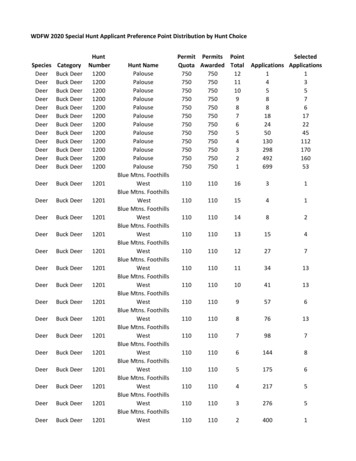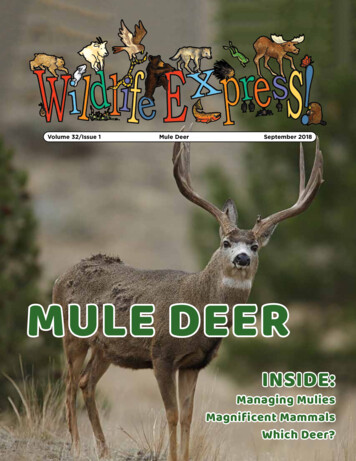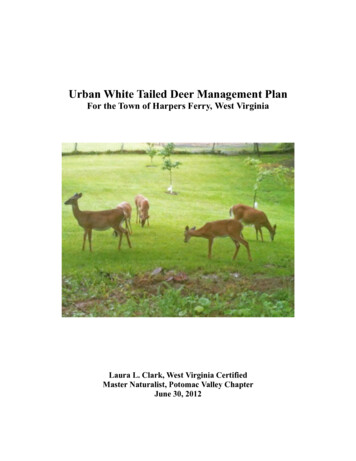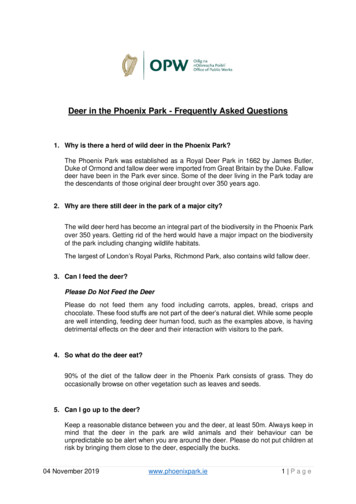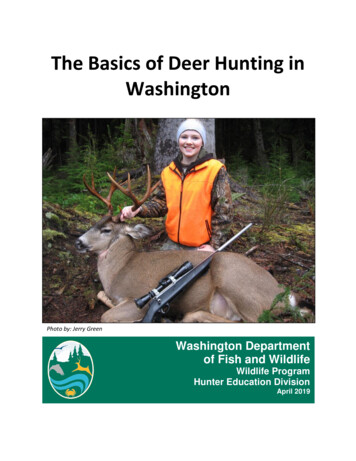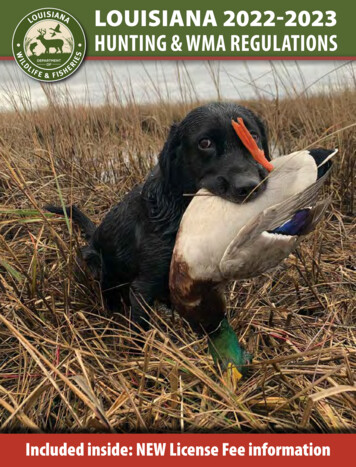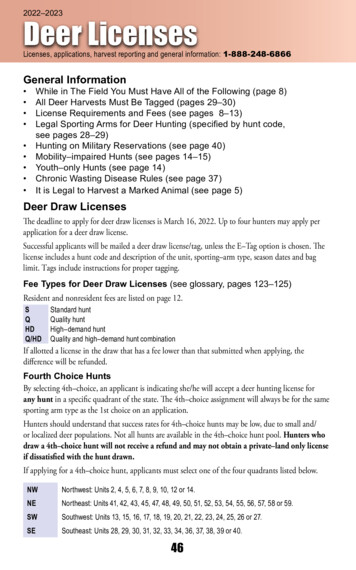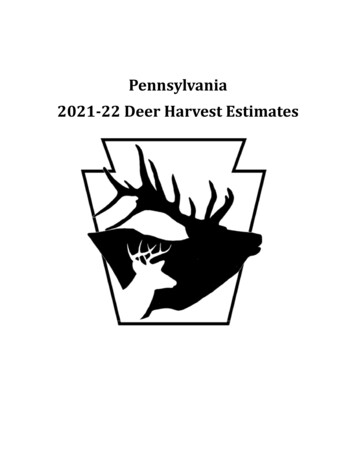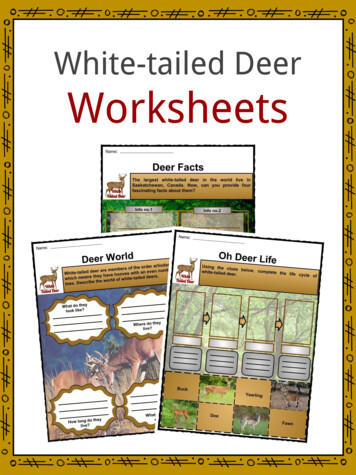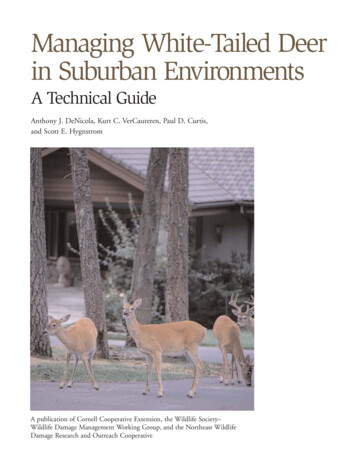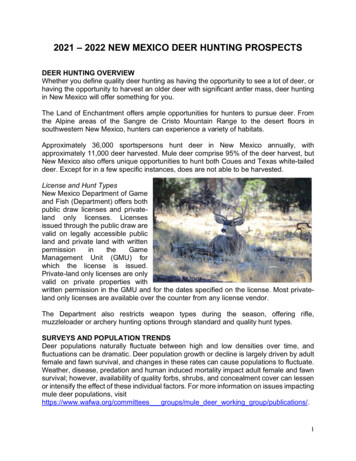
Transcription
2021 – 2022 NEW MEXICO DEER HUNTING PROSPECTSDEER HUNTING OVERVIEWWhether you define quality deer hunting as having the opportunity to see a lot of deer, orhaving the opportunity to harvest an older deer with significant antler mass, deer huntingin New Mexico will offer something for you.The Land of Enchantment offers ample opportunities for hunters to pursue deer. Fromthe Alpine areas of the Sangre de Cristo Mountain Range to the desert floors insouthwestern New Mexico, hunters can experience a variety of habitats.Approximately 36,000 sportspersons hunt deer in New Mexico annually, withapproximately 11,000 deer harvested. Mule deer comprise 95% of the deer harvest, butNew Mexico also offers unique opportunities to hunt both Coues and Texas white-taileddeer. Except for in a few specific instances, does are not able to be harvested.License and Hunt TypesNew Mexico Department of Gameand Fish (Department) offers bothpublic draw licenses and privateland only licenses. Licensesissued through the public draw arevalid on legally accessible publicland and private land with writtenpermissionintheGameManagement Unit (GMU) forwhich the license is issued.Private-land only licenses are onlyvalid on private properties withwritten permission in the GMU and for the dates specified on the license. Most privateland only licenses are available over the counter from any license vendor.The Department also restricts weapon types during the season, offering rifle,muzzleloader or archery hunting options through standard and quality hunt types.SURVEYS AND POPULATION TRENDSDeer populations naturally fluctuate between high and low densities over time, andfluctuations can be dramatic. Deer population growth or decline is largely driven by adultfemale and fawn survival, and changes in these rates can cause populations to fluctuate.Weather, disease, predation and human induced mortality impact adult female and fawnsurvival; however, availability of quality forbs, shrubs, and concealment cover can lessenor intensify the effect of these individual factors. For more information on issues impactingmule deer populations, visithttps://www.wafwa.org/committees groups/mule deer working group/publications/.1
Poor conditions for deer population growth in theearly-2000s resulted in suppressed deer numbersin several parts of the state. However, improvedconditions in recent years have led to increasedfawn recruitment and female survival. As a result,deer populations in New Mexico are stable, withmost herds experiencing population growth.The Department conducts post-hunt, aerialsurveys to determine buck to doe (B:D) and fawnto doe (F:D) ratios each winter and to monitoroverall population trends. The long-termstatewide averages are 39 fawns:100 does and35 bucks:100 does which are within theDepartment’s management objectives. Theseratios and trends indicate that the statewidepopulation is stable in most areas with somelocal variation in population trajectories.In general, deer herds in northern New Mexico arehealthy with some populations experiencing rapidgrowth.Although deer populations in southern NewMexico are lower than historical data suggests,F:D and B:D ratios have been improving overrecent years. Populations in southern New Mexico are stable with some local populationsseeing significant increases.LANDOWNERSHIPApproximately eleven percent of the land mass in New Mexico is tribally owned. Of theremaining land mass, approximately 50% is public land while the other 50% is privatelyowned. Public lands available to hunt deer in New Mexico include state owned andmanaged properties to federally owned and managed (Figure 1). Each jurisdiction hasdifferent rules for access and recreation on their properties.Additional information about rules for each landownership type can be found on theDepartment’s website or by accessing the links below.2
Figure 1. Map of Department GMUs and New Mexicosurface ownership.For more information on Federally Owned PropertyBureau of Land Managementhttps://www.blm.gov/node/7050US Forest Servicehttps://www.fs.usda.gov/r3US Fish and Wildlife Service National Wildlife Refuge s/NewMexico.htmlFor more information on State owned landsNew Mexico Department of Game and Fish Wildlife Management state-game-commission-lands/New Mexico State Land nfo.aspx3
HUNTING PROSPECTSNew Mexico is known for its mule deer hunting, and it is a destination for both residentsand non-residents who wish to harvest a high-quality mule deer buck. New Mexico hastwo subspecies of mule deer, Rocky Mountain mule deer and desert mule deer. Ingeneral, Rocky Mountain mule deer inhabit areas north of Interstate 40, while desert muledeer are found south of Interstate 40 (Figure 1).In addition to mule deer, New Mexico has two subspecies of white-tailed deer, Coueswhite-tailed deer (also known in hunting circles as the “gray ghost of the desert”) andTexas white-tailed deer. Southwestern New Mexico is known for its Coues white-taileddeer hunting opportunities. Coues white-tailed deer are found throughout most GMUs inthe Southwest portions of the state (Figure 2). Texas white-tailed deer can be found inpockets in the eastern portion of New Mexico from the Texas to Colorado borders as wellas in the Sacramento Mountains (Figure 3). Some Texas white-tailed deer have also beenobserved in the Sandia and Manzano Mountains in recent years.Figure 2. Coues white-taileddistribution in New Mexico.deerFigure 3. Texas white-taileddistribution in New Mexico.deer4
Opportunity vs QualityThe Department manages deer hunting for both “opportunity” and “quality”, depending onthe area. The hunt designation is listed in the Big Game Rule and Information Bookletunder the “Fee Type” for each listed hunt.--Standard hunts (also thought of as opportunityhunts) are managed to maximize annual hunteropportunity without negative impacts to overallpopulation health. These hunts typically provideapplicants with a higher chance of drawing adeer hunting license, but typically there is ahigher number of hunters in the area andsuccess rates may be lower as a result. Theaverage age of harvested bucks in standardunits is typically younger than that found inquality units.Quality hunts are designed to provide hunterswith some combination of lower hunter density,an increased opportunity for success and anability to choose from a wider selection of legalanimals. Quality hunts also may offer seasonstructures with varying timing and length thatmay provide longer hunts that are closer to therut. Draw odds in quality hunts are typicallylower, but success rates are generally higher forthose that draw a tag. In addition, the averageage of harvested bucks is generally greater thanthose harvested in standard units.Photo by E. DuvuvueiRegardless of area, weapon, or species hunted the harvest success rate for all deer huntsin New Mexico is approximately 35%. This success rate rivals that in other well-knowndeer hunting states in the west.Opportunity Hunting AreasGMUs 2B, 21, 23, 30, 31, 32, 34, 36 and 37 consistently have the highest deer harvestand many hunters successfully harvest bucks from these units annually. Areas with thehighest deer densities and greater potential to harvest any legal buck can be found in theGMUs that are on the northern border of New Mexico as well as the SacramentoMountains and the Guadalupe Mountains in the southeastern part of the state. Despitebeing managed for “opportunity”, older age class bucks can certainly be found in theseGMUs by hunters willing to put in some extra work.Quality Hunting AreasGMUs 2C, 4, 5B, 6A/6C, 31, 33 and 45 regularly produce mule deer that make the Booneand Crockett (B&C) record book. In addition, several mule deer bucks meeting the B&Cminimum have been taken in GMUs 13, 14 and 17 in recent years.5
Most large mule deer bucks are consistently harvested in the northwestern portion of thestate each year. In fact, Rio Arriba County, New Mexico has the most mule deer entriesin the B&C record book of any other county in North America. The sand hill country ineastern New Mexico also regularly produces bucks that make the B&C recordbook.Hunters wanting to harvest a B&C Coues whitetailed buck should consider GMUs 23, 24 and27. These units have produced record bookCoues bucks over the years.Photo by T. MitchussonHabitat and TerrainThe diverse terrain found in New Mexico offers a variety of deer hunting experiences. Thelist of habitats and GMUs below is not comprehensive but it gives hunters a general ideaof what type of hunting can be found across New Mexico.Mountains and Alpine (GMUs 6A/6C, 8, 14, 16, 17, 34, 36, 37, 45, 49, 51A/B, 52, 53,55A):These units offer a variety of hunting experiences that can be tailored to your specifichunting style. Hunters can glass from ridges or roads, stalk through timber, sit on trailsand water sources, or stalk bedded bucks in an alpine environment. A network of forestservice roads provide access to hunters wishing to conduct day trips near their camps orvehicles, while those looking to get away from the crowds can backpack in or set up spikecamps in the backcountry.Hunters can find deer from the lower mountain valleys to Wheeler Peak, the highest peakin New Mexico which stands at 13,161’. These GMUs are characterized by mountainousterrain containing dark conifer and aspen forests with pockets of open meadows andmountain shrubs. Hunters wishing tohunt deer specifically in alpineenvironments should consider GMUs45, 49 and 53 while the remainingunits offer deer hunting opportunitiesin a mountain environment belowtimberline. Deer in mountain habitatsmay migrate to lower elevations whenwinter snowpack becomes too deepto access food resources.Photo by O. Duvuvuei6
Forest Service land dominates these GMUs and access can be gained through theirnetwork of roads and trails (see link above). Hunting can be challenging at times due tosome rugged terrain that may require long, steep hikes, but success rates are high andmature bucks are taken in these units each year.Plains and Rolling Hills (GMUs 38, 39, 40, 41, 42, 47, 56, and 59):The eastern portion of the state where these GMUs are found is dominated by plains androlling hills with some canyons, escarpments, and sky island mountains in isolated areas.Shrublands, coulees and low conifer forests can be found where these breaks in theplains occur, and are often good deer habitat. To effectively hunt these GMUs, huntersmay spend several hours glassing the habitat before stalking within shooting distance.Successful hunters are effective at spotting deer that are hidden in plain sight and usingthe wrinkles in terrain to conceal their movements across the open habitat.Publicly accessible land is checkerboarded throughout these GMUs, and it is managedby the State Land Office (see link above) with the exception the Gallinas mountains inGMU 38 which is primarily forest service property. Extensive hiking opportunities are nottypically available; however, hunters can day hike from their vehicles to glass the terrainand stalk through the various tracts of public land. Access to these tracts is gained throughpublicly maintained roads. Because the terrain is generally gentler, hunting may not beas physically demanding as in other habitats.Since the terrain is more open, there is potential to see lots of deer in pockets in theseunits, and some large bucks can be found. Success rates in these GMUs can be high forrifle hunters but getting within bow range across the open habitat can be challenging.However, archery hunters find success in these units each year.GMUs 56 and 59 have a network of mesas and volcanic cones that are separated byexpanses of plains and grasslands. Public hunting in these units is available through theinterspersed patches of State Land Office property. Although this area isn’t known for itslarge bucks, deer densities are good and hunters can find good success in these units.Sand Hill Country (GMUs 31, 32, and 33):The sand hill country of eastern New Mexico is often overlooked by hunters seeking areaswith good deer numbers and bucks with large antlers. Although this area isn’t the firstplace that hunters think about when looking for a record buck in New Mexico, maturebucks are regularly harvested in this area. Deer antler growth is fueled by the shinneryoak and other nutritious forbs and shrubs found in this habitat, while the abundance ofcover allows for increased fawn survival and recruitment.Similar to the rolling hills and plains, hunters should plan to glass over large areas devoidof trees and plan their stalks using the rolling terrain to conceal their movement. Huntersin the sand hill country may not see as many deer as they might in the northwestern partof the state, and they may have to spend several hours glassing and hiking. However,deer are plentiful and an abundance of bucks are available to be harvested, some of7
which can qualify for the record books. State Land Office property and BLM land ischeckerboarded in these GMUs and access is gained through the publicly maintainedroads (see links above). Although these units have some large tracts of public land,backpacking opportunities are limited and day hikes from camp or the vehicle are themost common type of hunting.While GMUs 31 and 32 are managed for opportunity, GMU 33 is considered a qualityunit, and success rates in each of these GMUs are high. Depending on the hunter’sdesire, they can harvest the first legal buck to fill the freezer or hold out for a mature buckwhich can be found throughout the sand hill country.Canyons, Mesas, and Rimrock (GMUs 2A, 2B, 2C, 57, and 58):The northwestern and northeastern portions of New Mexico are characterized bycanyons, mesas and rimrock. This habitat allows for all methods of deer hunting. Hunterscan glass large expanses of habitat from a single vantage point or they can hike the manywooded draws, mountains and rimrock in search of a buck to take home.GMUs 2A, 2B and 2C in the northwestare dominated by sagebrush mesaswith pinyon and juniper along themesa edges and throughout thecanyons. These mesas and canyonsgive way to higher elevationmountainstotheEast.Landownership and hunting access inthe Northwest is predominatelyfederal land owned by the Bureau ofLand Management (BLM) and theU.S. Forest Service (USFS; see linksPhoto by O. Duvuvueiabove). The deer herd in these GMUsis largely migratory; they migrate 40-70 miles from the high summer range of the SanJuan Mountains in Colorado to winter in the Rosa area near Farmington. The migrationstarts in the middle of October each year regardless of snowpack, and the deer arrive onthe winter range in NM within 14 days. Deer hunting licenses in GMUs 2B and 2C arehighly sought after by hunters looking to fill their freezer or take a B&C buck; several bigbucks are harvested in these GMUs each year.GMUs 57 and 58 have a network of mesas, coulees and volcanic cones. The slopes andcoulees are dominated by scrub oak and pinyon-juniper woodlands while the mesa topsare predominately grasslands. Public land hunting opportunities is available oncheckerboarded State Land Office properties.Desert Habitat (GMUs 18, 20, 21B, 25, 26, 27, 28, 29, 30, and portions of 31 and 32):Most GMUs in the southern portion of the state are characterized by desert habitat withsome river bottoms and drainages interspersed throughout. Deer densities can besporadic in desert habitats, but good numbers can be found in pockets throughout these8
units. Deer densities and population trends in desert habitats are largely influenced bythe timing and amount of rainfall. In dry years, deer will typically be within 1.5 miles ofwater sources in desert habitats.These units have an expansive network of public land ranging from BLM, USFS and StateLand Office properties (see links above). Access to these public lands is gained throughpublicly maintained roads and the system of BLM and USFS roads.The desert habitat in New Mexico provides a great opportunity for hunters to fill the freezerwith a legal buck, but they aren’t known for regularly producing record book mule deerbucks. Despite this, a few hunters take home mature mule deer every year. To locatedeer in this country, hunters find it best to sit at a vantage point and glass the open terrainand shrubby draws. Once a buck is spotted, hunters will use the wrinkles in the landscapeto hide their movements and get in shooting range. Some hunters, however, prefer to sitnear water sources and wait for the bucks to come in for a drink.Photo by E. DuvuvueiWhat to expect for the 2021-2022 seasonThe last few years have been dry throughout much of New Mexico which has resulted inslightly lower fawn recruitment. Despite the drought conditions, adult buck and doesurvival remains consistent and harvest success rates are steady. Deer numbers arestable but average throughout much of the state. As such, hunters will not likely see a9
noticeable increase in deer populations or observations during their hunts. However, anabundance of bucks remain on the landscape and will be available for harvest.If you have any questions about applying for a New Mexico hunt, you can contact theinformation center toll free at 1-888-248-6866.The next Deer Rule will open in 2022, and the Department encourages our constituentsto remain engaged in the rule development process by submitting official comments.10
general, Rocky Mountain mule deer inhabit areas north of Interstate 40, while desert mule deer are found south of Interstate 40 (Figure 1). In addition to mule deer, New Mexico has two subspecies of white-tailed deer, Coues white-tailed deer (also known in hunting circles as the "gray ghost of the desert") and Texas white-tailed deer.
